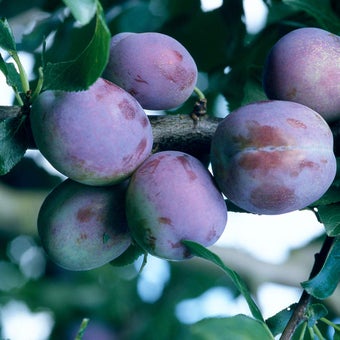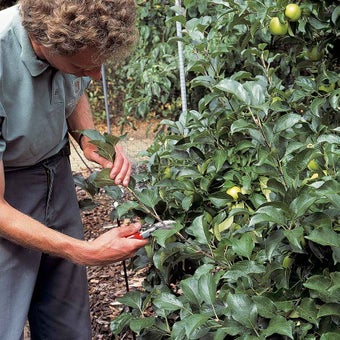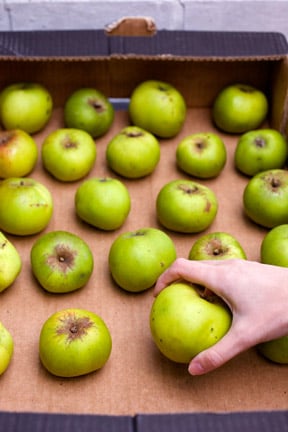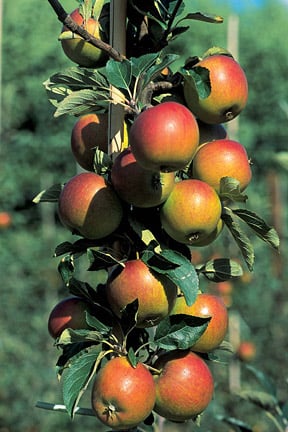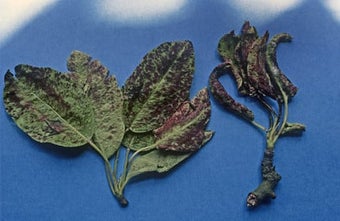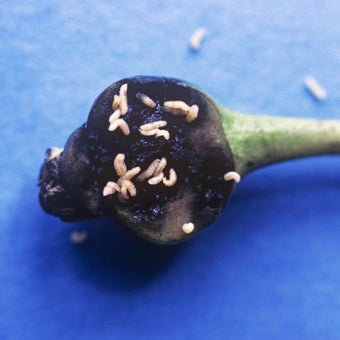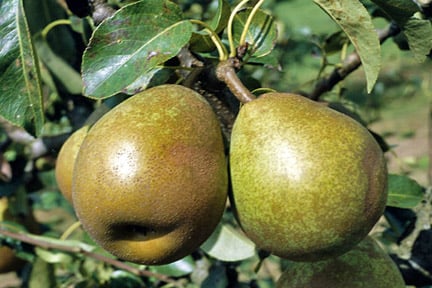
Quick facts
Pears grow best in sunny, sheltered spots
Grow two compatible trees for reliable pollination
Choose from culinary and dessert cultivars
Practical considerations
With so many different pear trees available, it can be confusing which is the right for you. As a result, it is worth considering the following:
Site: Pears need more warmth and sunlight than apples to fruit well. They also flower earlier so are more at risk from spring frosts. Provide a warm, south- or west-facing, sheltered site in your garden for the best results.
Garden size: If size is no restriction, choose a half-standard tree, but they are too large for the average garden. Where size is an issue, consider a bush, spindlebush, pyramid or . These all can be grown in a small space, or even in a pot. Alternatively, train pears as espaliers or fans flat against a sunny wall or fence.
Dessert (eating) or culinary (cooking): Pear cultivars are either dessert or culinary, although some are dual-purpose.
Storage: Harvest early-season pears while still under-ripe (early August). Picked fruit ripens quickly. Mid-season pears ripen in September and should be harvested while immature in late-August.
The majority of pears are late-season and should be harvested in mid- to late September when the first windfalls appear. Treat very late pears the same as very late apples, leaving them on the tree until the forecast of hard frost. These ripen in storage.
Taste: Flavour is one of the important consideration for most gardeners. Organised autumn fruit tasting events are a useful way to determine favourites. Unfortunately imported cultivars sold in supermarkets are from warmer countries, and have a different flavour when grown in Britain, even if they grow well, which is often not the case. However, there is a guide to taste under the ‘quality’ category listed for each below.
Disease resistance: Resistance to disease is another consideration which varies between cultivars, with modern types often having higher levels of resistance than traditional ones.
Pollination group: For the best yields, pears need pollination from a different cultivar that flowers at the same time. If you have a large enough garden, you can plant two different cultivars (pollination partners). But most gardeners do not have this luxury, so need to rely on pollen from a neighbouring pear tree.
In the selection of a pollinator, choose from within the same pollination group (flowering period) or from the adjoining groups, where flowering periods overlap. Triploids marked (T) are poor pollinators and where these are planted, two additional pollinators are necessary to cross pollinate the (T) variety and each other.
Rootstock: Most tree fruits are grafted onto rootstocks. It is the rootstock more than anything else which controls the size of the tree. Quince C or A are both semi-vigorous but Quince C is slightly less vigorous than Quince A. See our advice on rootstocks for fruit for further information.
Cultivar selection
The following have proved to be reasonably reliable, though pears flower early and are therefore at risk from spring frosts.
Dessert (eating) cultivars
Name:Beth AGM
Pollination group: 3
Season of use: Early to mid-September
Quality: Excellent
Comments: Hardy and reliable, early into cropping; small, sweet, juicy fruits.
Name:Beurré Hardy AGM
Pollination group: 3
Season of use: October
Quality: Good
Comments: Vigorous, upright tree; some scab resistance; slow to start bearing fruit; hardy; medium to large fruits, good pollinator for other pears.
Name:Conference AGM
Pollination group: 3
Season of use: October to November
Quality: Good
Comments: Reliable, heavy cropper; juicy and sweet, can set fruit without pollination.
Name:Concorde AGM
Pollination group: 3
Season of use: October to November
Quality: Excellent
Comments: Compact tree; reliable, quick to start fruiting.
Name:Doyenné du Comice AGM
Pollination group: 4
Season of use: late October to end of November
Quality: Good
Comments: Melting, juicy flesh; needs a sunny spot to fruit well; susceptible to scab.
Name:Louise Bonne of Jersey
Pollination group: 2 (will not pollinate Williams’ Bon Chrétien)
Season of use: October
Quality: Good
Comments: Melting flesh; small to medium fruits; reliable and hardy.
Name: Merton Pride
Pollination group: 3 (T)
Season of use: Mid- to late September
Quality: Excellent
Comments: Fine textured fruits, very juicy; vigorous tree but only a moderate cropper.
Name:Onward
Pollinationgroup: 4 (unsuitable as a pollinator for Doyenné du Comice and vice versa)
Season of use: September to October
Quality: Excellent
Comments: Melting flesh and juicy fruits; hardy and reliable.
Name:Pitmaston Duchesse AGM
Pollination group: 4
Season of use: October to November
Quality: Good (dual purpose)
Comments: Melting, juicy flesh; vigorous tree.
Name:Williams’ Bon Chrétien AGM
Pollination group: 3 (unsuitable as a pollinator Louise Bonne of Jersey and vice versa)
Season of use: Mid September
Quality: Good
Comments: Musky flavour; hardy; prone to scab, may fruit on north-facing wall.
Culinary (cooking) cultivars
Name:Catillac AGM
Pollination group: 4 (T)
Season of use: February to April
Quality: A stewing pear
Comments: Hard, slightly gritty flesh, turns pink when cooked; hardy, failry vigorous, reliable tree.
T = Triploid, needing two other pollinators
B = Sometimes produces fruit alternate years if not pruned carefully ( )
